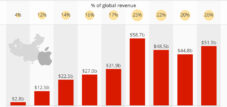China AI ends the era of invisible submarines – Is the future of submarines without underwater camouflage nearing its end?
Xpert pre-release
Language selection 📢
Published on: September 17, 2025 / Updated on: September 17, 2025 – Author: Konrad Wolfenstein

China's AI ends the era of invisible submarines – Is the future of submarines without underwater camouflage doomed? – Image: Xpert.Digital
China's Super AI Hunts: Only 1 in 20 Submarines Can Escape - How a New AI Weapon Unmasks the Invisible Submarines
### End of an era: Why the Navy's most powerful weapon is suddenly vulnerable ### Threat to world peace? How AI is tipping the balance of nuclear deterrence ### From sonar to quantum hunting: The high-tech revolution taking place underwater ###
Can submarines still hide? A new technology says a resounding no
For decades, they were considered the invisible hunters of the deep sea, the ultimate guarantee of a nation's second-strike nuclear capability: submarines. Their ability to glide undetected through the oceans made them one of the most powerful strategic instruments of the world's powers. But this era of unassailable stealth is coming to an end. A technological revolution, driven by artificial intelligence (AI), threatens to transform the oceans into a glass battlefield where there is no hiding place.
At the forefront of this development are Chinese researchers who have developed an AI-supported system that is rewriting the rules of underwater warfare. Computer simulations paint a grim picture: The chance of survival of an enemy submarine could drop to as little as five percent. Through the intelligent networking of sonar buoys, quantum sensors, and oceanographic data, the AI can predict maneuvers, expose deceptions, and adapt hunting strategies in real time – more effectively than any human commander.
This technological leap has far-reaching consequences. It not only challenges the multi-billion dollar stealth programs of Western navies, but also shakes the foundations of the global security architecture. If nuclear-armed submarines, once considered invulnerable, can suddenly be detected and engaged, the delicate balance of nuclear deterrence will be destabilized. The following sections illuminate the technologies behind this new form of submarine hunting, analyze its implications for maritime warfare, and demonstrate how Western nations are responding to this existential threat.
How is artificial intelligence changing submarine detection?
The development of artificial intelligence has the potential to fundamentally change underwater warfare. Chinese researchers have developed an AI-based anti-submarine system that, according to current computer simulations, could reduce the survival rate of enemy submarines to just five percent. This means that out of 20 submarines, only one would escape detection and subsequent attack.
The system operates as an intelligent commander in the oceans, leveraging data from various sensors such as sonar buoys, underwater sensors, radar, and oceanographic parameters such as seawater temperature and salinity. Unlike traditional search methods, the AI can make real-time decisions and adapt to submarines' countermeasures.
What technologies are behind the new submarine detection?
Modern submarine detection is based on several advanced technologies interconnected by AI. The three-layer architectural system includes a perception layer that combines real-time data from various sensors, a decision-making component, and a human-machine interaction layer.
Sonar buoys play a central role in this. These devices, approximately 13 centimeters wide and 91 centimeters long, are dropped into the water from aircraft or ships and deploy both a radio transmitter on the surface and hydrophones underwater. Modern systems such as the DIFAR sonar buoys can detect acoustic signals in the frequency range from 5 to 2,400 Hz and operate for up to eight hours at depths of up to 305 meters.
Magnetic anomaly detection is another key component. Submarines are primarily made of ferromagnetic materials and distort the Earth's magnetic field in their surroundings. This magnetic signature can be measured from aircraft, with modern AI systems helping to distinguish the weak signals from interference.
Why have previous submarine camouflage methods become less effective?
Traditional submarine stealth technologies focused on reducing the acoustic signature through sound-dampening materials, angular hull shapes, and shrouded propellers. These methods were quite effective against conventional sonar systems, but they reach their limits against AI-assisted multi-sensor systems.
The new AI systems also react to typical submarine countermeasures such as zigzag maneuvers, the use of decoys, or hiding in resting positions. Even when submarines use unmanned drones for deception, the AI retains its detection capabilities.
A particular problem arises from climate change, which is altering underwater acoustics. Rising sea temperatures and changing salinity levels affect sound propagation in the water, creating both opportunities and risks for submarine operations.
What role do quantum sensors play in submarine detection?
China has also developed drone-borne quantum sensors capable of detecting submarine magnetic anomalies with high precision. These systems use coherent population trap atom magnetometers with rubidium atoms, whose energy levels are influenced by magnetic fields.
In offshore tests near Weihai, the system achieved a detection accuracy of 2.517 nanotesla, which was improved to 0.849 nanotesla after correction. This technology is particularly effective in low-latitude areas such as the South China Sea, where the Earth's magnetic field is nearly parallel to the surface and conventional sensors exhibit weaknesses.
How does the three-layer AI architecture for submarine hunting work?
The system, developed by Chinese researchers, operates through a complex three-layer structure. The perception layer combines real-time data from sonar, radar, magnetic anomaly detectors, and oceanographic sensors to create dynamic underwater environment maps.
The decision-making layer analyzes this data and determines search strategies and necessary responses to submarine maneuvers. The third layer enables natural language communication between the system and human operators, reducing the cognitive load on the soldiers.
The system can coordinate various AI agents for automated decision-making and enables fully integrated multi-domain tracking across air, surface, and underwater platforms.
Hub for security and defense - advice and information
The hub for security and defense offers well-founded advice and current information in order to effectively support companies and organizations in strengthening their role in European security and defense policy. In close connection to the SME Connect working group, he promotes small and medium -sized companies (SMEs) in particular that want to further expand their innovative strength and competitiveness in the field of defense. As a central point of contact, the hub creates a decisive bridge between SME and European defense strategy.
Suitable for:
How AI is ending the age of invisible submarines: Autonomous drones and AI are revolutionizing underwater warfare
What does this mean for nuclear deterrence?
Submarines are a central component of the nuclear triad, which consists of land-based missiles, strategic bombers, and sea-based systems. Ballistic missile submarines (SSBNs) are considered the most survivable element of this triad because they are difficult to locate and provide a credible second-strike capability.
The United States currently operates 14 Ohio-class SSBNs, each capable of carrying up to 20 submarine-launched ballistic missiles with multiple independently homing warheads. These submarines are specifically designed for stealth and the precise delivery of nuclear warheads.
If submarines lose their ability to operate relatively undetected, this would have significant consequences for their deterrent potential. The Department of Defense plans to deploy up to 70 percent of the nation's nuclear warheads on SSBNs, underscoring their strategic importance.
How are Western navies reacting to this development?
The US Navy has already begun developing its own AI-based submarine detection systems. Charles River Analytics was awarded a one-million-dollar contract to develop the MAGNETO system, which uses AI to identify enemy submarines based on their magnetic signatures.
The MAGNETO system uses a hierarchical approach that progressively refines signal identification through successive stages. This enables real-time data processing and ensures that only relevant signals are forwarded for more detailed analysis.
Ultra Maritime has developed Sea Spear, a lightweight, deployable sonar system that quickly and cost-effectively enhances submarine detection capabilities. The system can be deployed from manned or unmanned surface and underwater platforms and expands to a high-performance, wide-area array.
What impact does this technology have on maritime warfare?
The introduction of AI-assisted anti-submarine warfare could herald the end of the era of "invisible" submarines. This would represent a fundamental shift in maritime strategy, as submarines have played a crucial role in naval dominance since World War II.
Modern stealth submarines such as the German Type 212CD, with its angular outer hull designed to minimize sonar signature, or Sweden's A-26 Blekinge class could become less effective against these new detection systems. Adapting stealth principles from aviation to the underwater domain is proving more complex than originally thought.
The integration of unmanned underwater vehicles (UUVs) with nuclear-powered Virginia-class submarines is already transforming underwater warfare. This breakthrough technology improves autonomous launch and recovery operations and strengthens electronic warfare and intelligence, surveillance, and reconnaissance operations.
How are countermeasures and defense strategies developing?
The development of advanced detection technologies is simultaneously leading to innovative countermeasures. Just as radar systems evolved to combat stealth aircraft, sonar systems are also becoming more sophisticated in detecting stealth submarines.
China is working on AI-guided torpedoes that can distinguish real submarines from underwater decoys. Early tests show that the system can distinguish real targets from decoys with an average accuracy of 92.2 percent. The system improved detection rates from about 61 percent to over 80 percent, even against advanced decoys.
The Royal Navy is planning Project CABOT, a persistent barrier in the North Atlantic consisting of networked unmanned vehicles with advanced sensor systems. This barrier promises transformative strategic significance and revolutionary development speed.
What are the challenges of implementation?
The implementation of AI-based anti-submarine systems presents various technical and strategic challenges. The magnetic field signals of submarines are extremely weak—approximately 0.2 nanotesla at a distance of 600 meters, or 13.33 nanotesla at a distance of 500 meters for a 100-meter-long submarine.
Interference from other metallic objects and electrical devices poses another problem. AI and machine learning help isolate and extract relevant signals from the surrounding noise.
The US Navy is pursuing a phased approach to implementing tactical and evolutionary AI-powered anti-submarine warfare. Rather than replacing acoustic operators with machines, the goal is to support them with AI-assisted technology during training and operations.
What international impact can be expected?
China's development of advanced anti-submarine technologies has already sparked international reaction. Experts view these systems as crucial to China's ability to protect its aircraft carriers and ensure successful amphibious operations.
Also significant is that Chinese air-launched submarine chasers are tasked with protecting Chinese ballistic missile submarines as they travel to their patrol and launch areas. China views air-launched anti-submarine warfare as an important enabler of its nuclear deterrent at sea.
Thales has developed BlueScan, an integrated acoustic system that enables real-time multi-sensor data fusion and analysis of heterogeneous data. Powered by artificial intelligence, it enhances collaborative anti-submarine warfare to strategically position navies for the complex challenges of tomorrow.
What might the future of underwater warfare look like?
The future of underwater warfare will be revolutionized by the integration of autonomous platforms and real-time data integration. Artificial intelligence, autonomous platforms, and real-time data integration are transforming the way navies detect, track, and neutralize submarines.
The development of stealth-capable autonomous underwater drones opens up new possibilities. These vehicles can use their self-generated sound as a passive sonar source to map the seafloor without having to emit active sonar signals.
The most important response to AUV platforms and systems would be to strengthen maritime control by upgrading and expanding current surface, underwater, and air capabilities. This requires a comprehensive reorientation of maritime defense strategies and significant investments in new technologies.
The era of "invisible" submarines, long a cornerstone of maritime deterrence, could indeed come to an end due to these technological developments. This would fundamentally change not only maritime warfare but also the entire balance of nuclear deterrence, requiring new strategic considerations for all naval powers in the world.
Advice - planning - implementation
I would be happy to serve as your personal advisor.
Head of Business Development
Chairman SME Connect Defense Working Group
Advice - planning - implementation
I would be happy to serve as your personal advisor.
contact me under Wolfenstein ∂ Xpert.digital
call me under +49 89 674 804 (Munich)




















